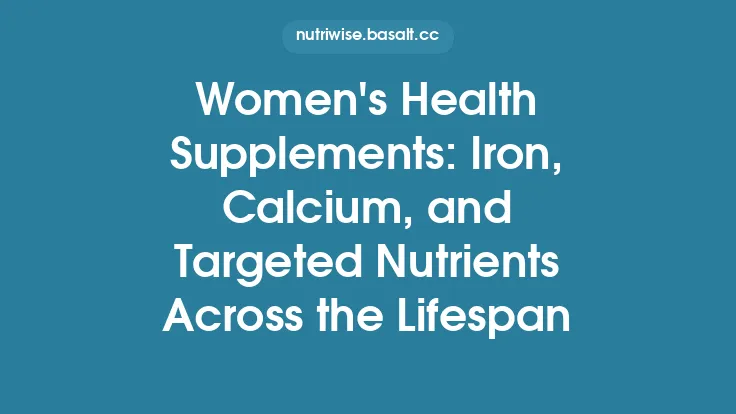Vitamin K is a fat‑soluble micronutrient essential for the synthesis of several clotting factors (II, VII, IX, and X) and regulatory proteins that keep the coagulation cascade in balance. Because the body cannot produce sufficient vitamin K on its own, a steady daily intake is required to maintain normal hemostasis. The amount needed varies throughout life, reflecting differences in body size, growth velocity, metabolic rate, and physiological demands such as pregnancy or aging. Understanding these age‑specific requirements helps clinicians, dietitians, and individuals plan diets that consistently support optimal blood‑clotting function.
Why Daily Vitamin K Intake Matters for Coagulation
The clotting cascade is a tightly regulated series of enzymatic reactions that culminate in the formation of a fibrin clot. Vitamin K acts as a co‑factor for the enzyme γ‑glutamyl carboxylase, which converts specific glutamic acid residues on clotting proteins into γ‑carboxyglutamic acid (Gla) residues. This post‑translational modification enables the proteins to bind calcium ions, a prerequisite for their attachment to phospholipid surfaces and subsequent activation. Without adequate vitamin K, the synthesis of functional clotting factors is impaired, leading to prolonged bleeding times. Because the half‑life of vitamin K‑dependent clotting factors ranges from 6 hours (factor VII) to 72 hours (prothrombin), a continuous supply of the vitamin is needed to replace proteins that are naturally turned over.
Recommended Intakes by Age Group
Health authorities such as the Institute of Medicine (IOM, now the National Academy of Medicine) and the European Food Safety Authority (EFSA) have established Dietary Reference Intakes (DRIs) for vitamin K, expressed as Adequate Intakes (AIs) because a precise Estimated Average Requirement (EAR) has not been determined. The AI values are based on the amount needed to achieve normal blood coagulation, as measured by prothrombin time, in healthy individuals.
| Life Stage | AI (micrograms per day) – Vitamin K1 (phylloquinone) |
|---|---|
| Infants 0–6 mo | 2 µg |
| Infants 7–12 mo | 2.5 µg |
| Children 1–3 yr | 30 µg |
| Children 4–8 yr | 55 µg |
| Boys 9–13 yr | 60 µg |
| Girls 9–13 yr | 60 µg |
| Boys 14–18 yr | 75 µg |
| Girls 14–18 yr | 75 µg |
| Men 19 yr and older | 120 µg |
| Women 19 yr and older | 90 µg |
| Pregnant women (any age) | 90 µg |
| Lactating women (any age) | 90 µg |
Note: The AI values are expressed for phylloquinone (vitamin K1), the predominant dietary form. Menaquinones (vitamin K2) contribute to total vitamin K status, but specific AI values for K2 have not been established.
Infants (0–12 months)
During the first year of life, vitamin K requirements are modest because the infant’s blood volume is relatively small and the turnover of clotting factors is lower than in older children. Newborns receive a prophylactic vitamin K injection (typically 1 mg of phytonadione) shortly after birth to prevent hemorrhagic disease of the newborn, a condition arising from low hepatic stores and limited intestinal synthesis. After this initial bolus, the AI of 2–2.5 µg per day can be met through breast milk (which contains low but bioavailable amounts of vitamin K) or infant formula (fortified to meet the AI). Because infants have immature bile secretion, fat absorption is less efficient; however, the low absolute requirement compensates for this limitation.
Children (1–8 years)
Rapid growth and increasing body mass in early childhood raise the daily vitamin K need to 30–55 µg. The AI reflects the amount required to sustain normal prothrombin times in a growing child. At this stage, the gastrointestinal tract matures, and bile production improves, enhancing the absorption of fat‑soluble vitamins. The gut microbiota also begins to produce menaquinones, contributing modestly to overall status, though dietary intake remains the primary source.
Adolescents (9–18 years)
Puberty introduces a surge in lean body mass, hormonal changes, and increased metabolic activity, all of which elevate the demand for vitamin K to 60–75 µg per day. The AI for both sexes converges because the physiological need for clotting factor synthesis is similar, despite differences in body composition. Adolescents also experience higher rates of physical activity and occasional injuries, making consistent vitamin K intake more relevant for maintaining hemostatic competence.
Adults (19–50 years)
In adulthood, the AI stabilizes at 120 µg for men and 90 µg for women. These values account for the larger average body mass of men and the slightly lower basal metabolic rate in women. The adult AI is designed to maintain a steady pool of functional clotting factors throughout a typical lifespan, assuming normal absorption and no underlying disease that would increase turnover (e.g., chronic liver disease).
Older Adults (51 years and beyond)
Aging is associated with several physiological changes that can affect vitamin K status:
- Reduced bile production – Diminished secretion can impair the micellar solubilization of vitamin K, decreasing its absorption efficiency.
- Altered gut microbiota – The composition of intestinal flora shifts with age, potentially lowering endogenous menaquinone synthesis.
- Increased prevalence of malabsorptive conditions – Disorders such as celiac disease, pancreatic insufficiency, or use of cholestyramine can further limit absorption.
Despite these factors, the recommended AI for older adults remains the same as for younger adults (120 µg for men, 90 µg for women). However, clinicians often advise monitoring vitamin K status in elderly patients, especially those on long‑term antibiotics or with chronic gastrointestinal disease, to ensure that the AI is truly sufficient.
Pregnancy and Lactation
Pregnant and lactating women have an AI of 90 µg per day, identical to that of non‑pregnant adult women. This recommendation reflects the need to support both maternal hemostasis and the developing fetus, which relies on maternal vitamin K for the synthesis of its own clotting factors. While the placenta actively transports vitamin K, the fetal requirement is modest; thus, the maternal AI is considered adequate for both parties. During lactation, vitamin K is secreted into breast milk, albeit in low concentrations, and the AI ensures that the mother’s stores are not depleted.
Factors That Modify Vitamin K Needs
Although the AI provides a baseline, several individual factors can increase or decrease the effective requirement for vitamin K:
| Modifier | Effect on Requirement | Mechanism |
|---|---|---|
| Fat malabsorption (e.g., cystic fibrosis, bariatric surgery) | ↑ | Impaired incorporation of vitamin K into micelles reduces bioavailability. |
| Broad‑spectrum antibiotics | ↑ | Suppression of gut bacteria diminishes endogenous menaquinone production. |
| Genetic polymorphisms (e.g., VKORC1, GGCX) | Variable | Alter enzyme activity in the vitamin K cycle, potentially affecting turnover rates. |
| High‑intensity endurance training | Slight ↑ | Increased micro‑vascular injury may modestly raise clotting factor turnover. |
| Chronic liver disease | ↑ | Impaired synthesis of clotting factors may demand higher vitamin K to achieve functional levels. |
| Obesity | Possible ↑ | Larger adipose tissue mass can sequester fat‑soluble vitamins, reducing circulating levels. |
| Age‑related decline in bile acids | ↑ | Diminished emulsification leads to lower absorption efficiency. |
When any of these conditions are present, clinicians may consider a more individualized assessment of vitamin K status, often using plasma concentrations of under‑carboxylated osteocalcin or prothrombin time as indirect markers.
Assessing Your Intake
- Dietary Recall or Food Frequency Questionnaire (FFQ):
A structured 24‑hour recall or a validated FFQ can estimate average daily vitamin K intake. Because the AI is relatively low, most balanced diets meet the requirement, but the assessment helps identify gaps in high‑risk groups.
- Biochemical Markers:
- Prothrombin Time (PT): Prolonged PT can indicate functional vitamin K deficiency, though it is not specific.
- Under‑carboxylated Matrix Gla‑Protein (ucMGP) and Osteocalcin: Elevated levels suggest suboptimal vitamin K status, useful in research settings.
- Clinical Evaluation:
A thorough history should include medication use (especially antibiotics, lipid‑lowering agents), gastrointestinal health, and any recent surgeries that could affect absorption.
Practical Tips for Meeting the Recommendations
- Aim for Consistency: Because vitamin K is stored in the liver and adipose tissue, daily intake helps maintain a stable pool. Sporadic high‑dose consumption is less effective than regular moderate intake.
- Include Healthy Fats: Vitamin K is fat‑soluble; consuming it with a modest amount of dietary fat (e.g., a teaspoon of oil) enhances absorption, especially important for individuals with marginal bile production.
- Consider Fortified Products: For those with malabsorption, fortified foods (e.g., certain plant milks or cereals) can provide a reliable source without relying on whole‑food intake.
- Monitor High‑Risk Situations: Patients on long‑term antibiotics or with chronic liver disease should have periodic PT checks and dietary counseling to ensure the AI is being met.
- Balance with Overall Micronutrient Needs: Vitamin K works synergistically with vitamin D and calcium in bone health; a holistic approach to micronutrient adequacy supports both hemostasis and skeletal integrity.
Conclusion
Daily vitamin K intake is a cornerstone of effective blood coagulation throughout the human lifespan. The established Adequate Intakes—ranging from 2 µg in early infancy to 120 µg in adult men—reflect the evolving physiological demands of growth, reproduction, and aging. While the baseline AI suffices for most healthy individuals, specific life stages and health conditions can modify absorption and utilization, necessitating a more nuanced assessment. By understanding these age‑specific requirements and the factors that influence them, health professionals can guide patients toward dietary patterns that reliably sustain optimal clotting function, thereby reducing the risk of bleeding complications and supporting overall vascular health.





